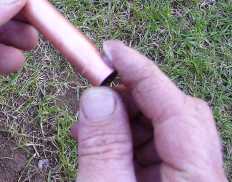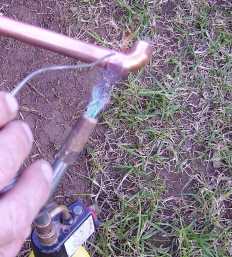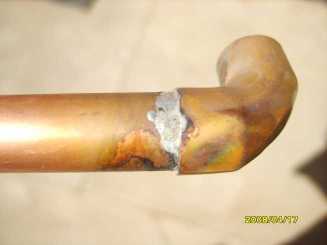How To Solder Copper Pipe
|
How to solder copper water pipes.You may be wondering why a plumber is giving away a "trade secret" on how to solder copper water pipes? Actually it's no secret, and if you are reading this then there is a fair chance that you are going to do do it anyway. So, if you are going to do it we may as well try to help you do a good job :-)! The instructions below explain how to solder a capilary joint. Neither Blockbuster nor the Author accepts and liability for how, where or how badly the job is done. You are on your own - follow the instructions and use at your own risk! Also follow the instructions that came with your blowtorch. Solder gets hot. I have a couple of scars that bear this out. Dont get the flux in your eyes!!! 1. Tools Required. You need a blowtorch to start. I use a Bernzomatic MAPP gas torch with pushbutton ignition. It's a tad bulky but is by far the most versatile and reliable torch I have used. You don't need a MAPP torch. A butane or propane torch will do as long as it can melt the solder. You will also need a pipe cutter or hacksaw. Pipe cutter is better but a hacksaw works - just try to cut the pipe square! Also you will need some plumber's solder and a tub of flux. You should be able to get all this stuff at most decent hardware shops in South Africa. Lastly a sheet of 80-100 emery cloth is handy. Also, you obviously need some copper pipe and copper or brass capillary fittings. 2. Preparation, is the key to your success. You must have a good idea of what you want to solder, where the pipe needs to go and what fittings you need. I am not going to tell you how to lay out the job - that's where I make my cash, but will explain how to solder a capillary joint. Why would you need to do a capillary joint? The most common reason is because a pipe is broken or an existing fitting has been turned or broken off. First you need to clean up the end of the pipe and inside the capilary fitting. A plain 90 degree elbow is used as an example here. Tear a 25mm strip of emery paper and sand the pipe and joint (inside) until shiny. This is a KEY step! The parts must be free of dirt, oil, soap and oxidation!
3. Next you coat the pipe and the inside of the joint with flux paste. Coat liberally and do the joint AND the pipe - not just the pipe. Plumbers just do the pipe and 10% of their joints have to be re-soldered! (joke). Also see point 10 at the bottom of the page.
4. Make sure you have something at hand to hold the pipe with. It's all going to get HOT. Un-roll about 5-8cm of solder from the roll. Light your torch. Apply heat to the pipe and fitting along the line that the flux it steaming out of. You may move the torch around the joint so as to distribute the heat evenly. If you have a MAPP torch then you are not going to have to do this for long. When the flux starts to really cook apply some solder to the pipe, at the joint, to see if it melts and flows. When it does, feed the solder into the crack between the two parts.
5. Watch the solder - it must get "sucked in" and flow into the joint. You need only a bit more that the circumference of the pipe. No harm in using a bit more at first though. 6. When you see a "ring" of solder around the pipe stop and wait for the solder to solidify. Give it a bit of time while keeping the work piece DEAD still. When its well set you can splash some water on it to cool it off faster.
7. Right. That's it. Test the joint by fitting it and applying water pressure. It must be absolutely water tight. Not even a trace of a drip or weep. If it does leak then you should redo the joint from scratch using new components. Soldering TIPS. 1. Be carefully not to overheat the pipe - especially if you are using a MAPP torch. If the flux turns to carbon or the copper changes colour then the pipe is way too hot. 2. Spread the heat around the circumference. This particularly with 3/4 (22mm) fittings. Again important with MAPP. It heats so fast that the far side is cool while the torch side is ready to solder. 3. Make VERY sure that the pipe is pushed as far in as it will go. A pipe that is only 2mm into the joint will fail one day. 4. You can get another try at an imperfect joint by adding flux paste to the crack, heating and running solder in again. Not recommended but it does work most of the time. 5. The best joints are horizontal and downwards. Joints where the solder has to "suck in" upwards can be a bit problematic for a novice. Avoid these to start. Do them on the floor and then connect to the pipe with a "down" or "side" flowing joint. 6. Watch out that you don't apply heat to areas that don't tolerate heat! Plastic fittings, wood, plastic, PTFE tape etc. 7. Remember that you cannot solder a pipe that has water in it! Don't even try. Either dry it out or plug it with a lump of compressed brown bread. White also works, but I generally use brown :-). Leave the bread there. The water pressure will blow it out later. Push the lump in so that it stops the water before your joint that you are going to solder. 8. You can fill small (2-3mm) holes in copper pipe with solder. The pipe must be dry inside and you must sand around the hole. Clean inside the hole if you can. Douse with flux and run the solder into the pipe a bit. A better way is to use a capillary "sleeve" (plain connector) that you have split into 2/3 lengthways. Use a hacksaw. Clean the pipe and the inside of the 2/3 sleeve. Flux the sleeve and "tin" it with solder first. In other words run a thin layer of solder over the inside. Then clip it over the FLUXED pipe covering the hole. Heat the sleeve and pipe and run in a tad more solder. This type of repair will take 20 Bars and beyond. 9. In an emergency you can seal off a pipe by cutting it and bending the end flat like a toothpaste tube. You can make this watertight by running some solder into the "seam". You must clean and flux though. Surprisingly I have pressure tested one of these makeshift stoppers and it held to over 40 Bar! 10. Do NOT under any circumstances get the FLUX into your EYES!!! This is a very painfull experience that is going to make you sad, mad and very grumpy for a while. If this does happen then flush with water and immediatly go and test your medical aid plan at your local GP or hospital. Mention "acid flux" - they will know what to do :-).
You may mail me at info@blockbusterdrain.co.za with soldering questions. Please don't PHONE me for this!
|




